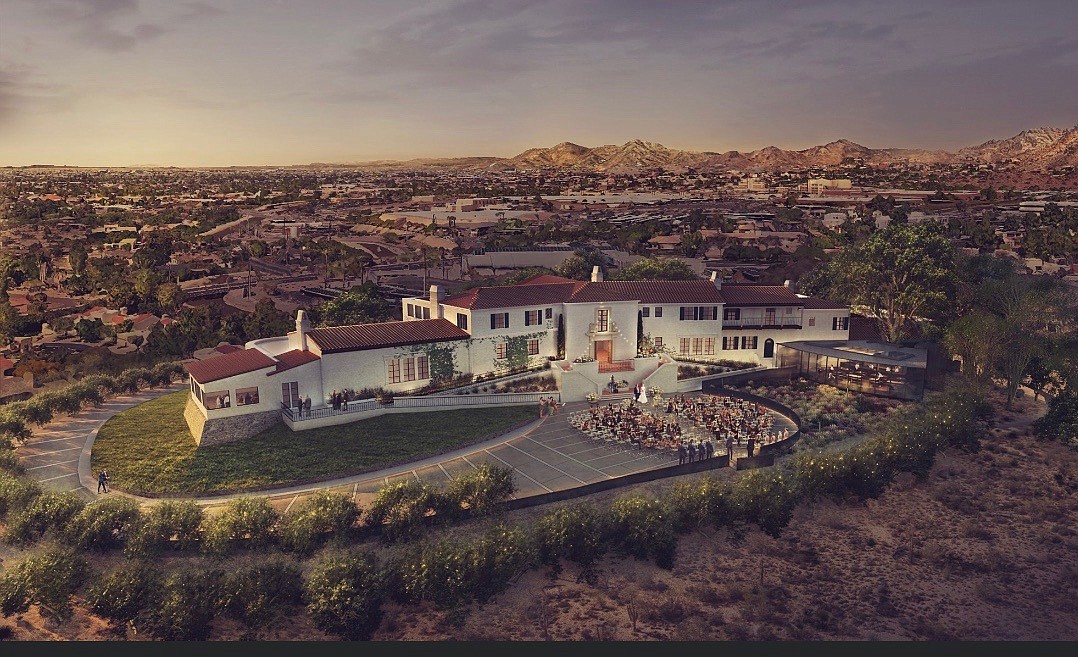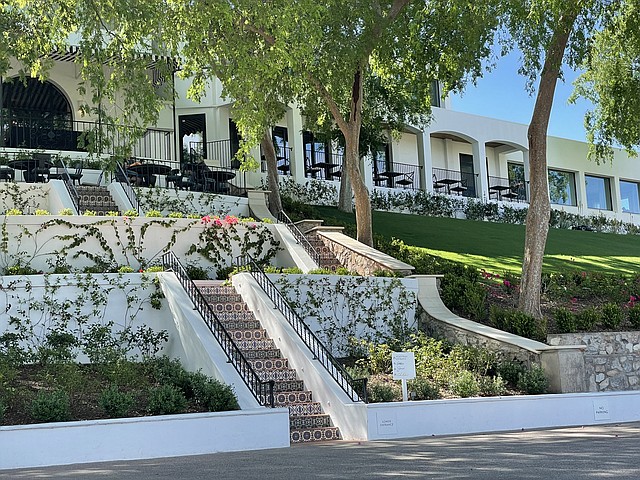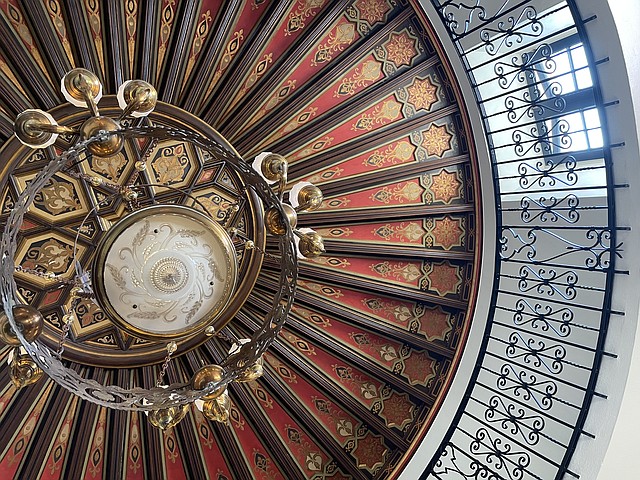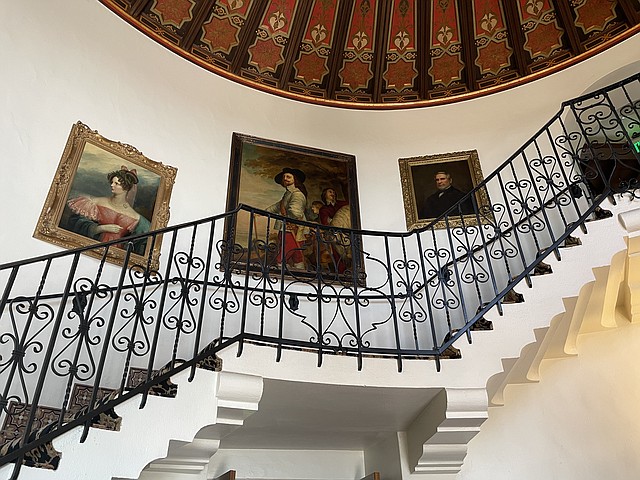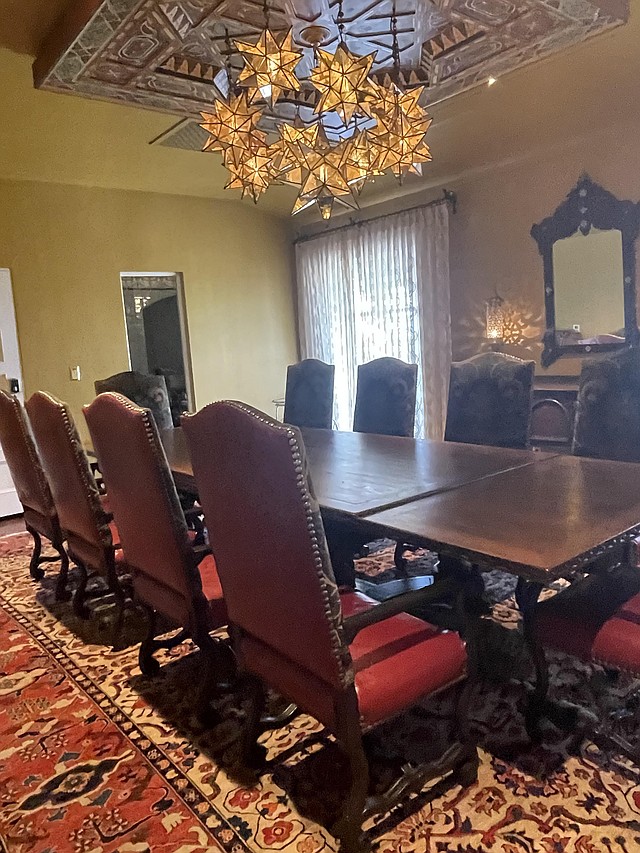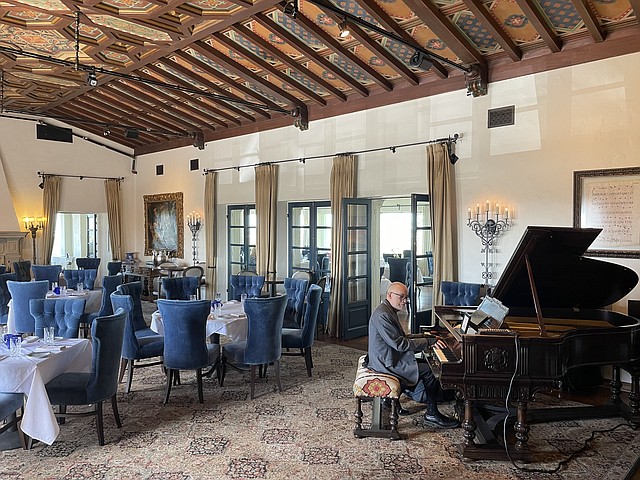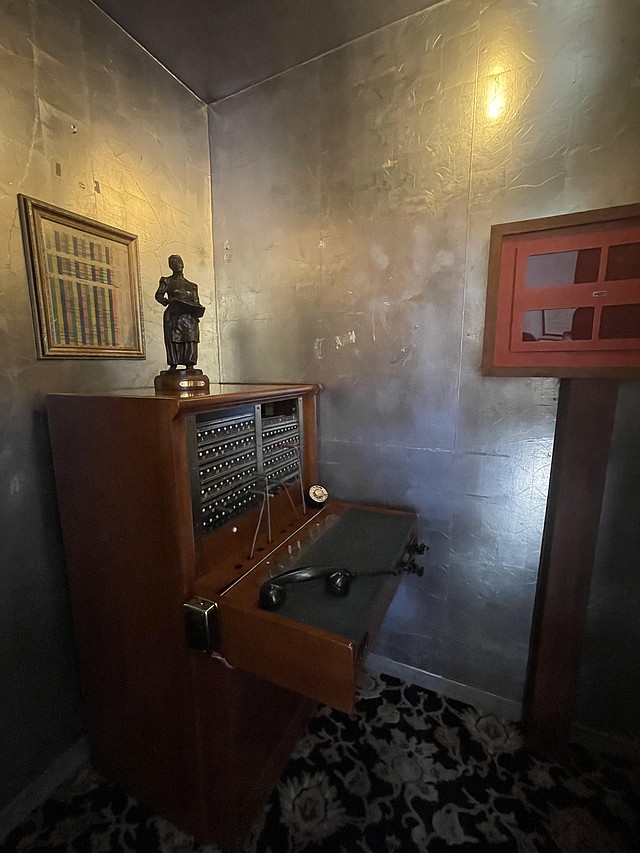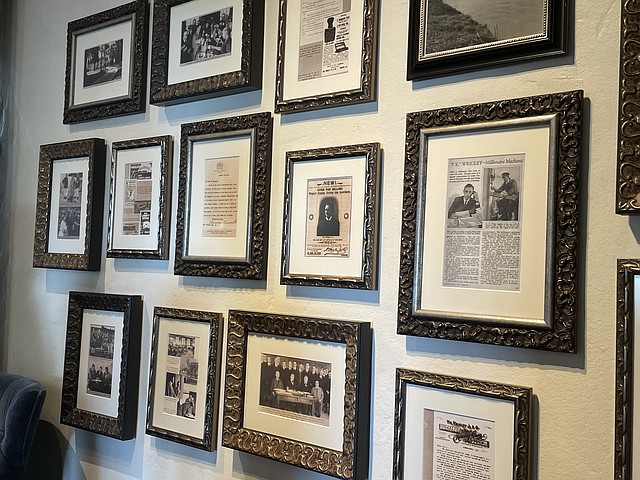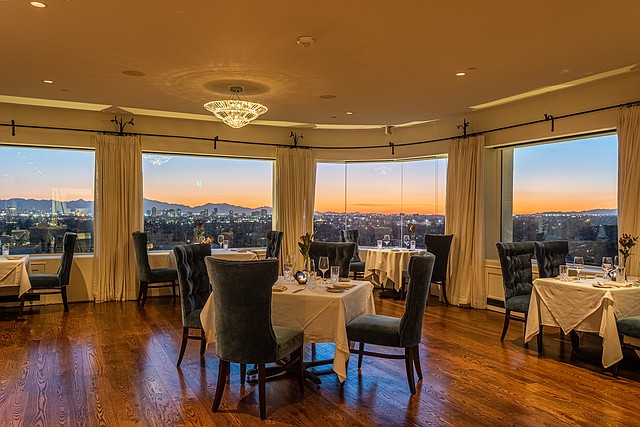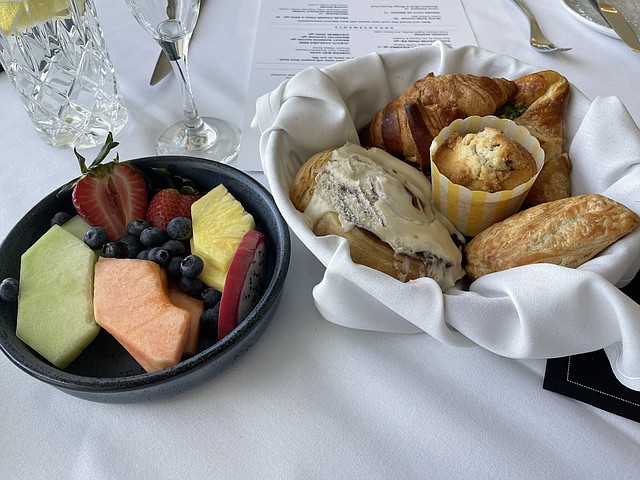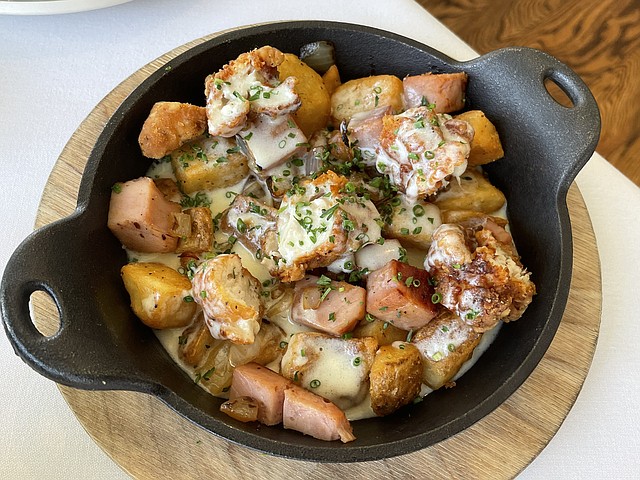Tour historic Wrigley Mansion, then dine in style
Travels with Deb
July 18, 2022 at 6:00 a.m.
...by DEBBIE STONE
Born and raised in Chicago, I knew the Wrigley Building well, as it is one of the city’s famous architectural landmarks. And the man behind it, William Wrigley Jr., was the chewing gum magnate. The young entrepreneur started his career by selling soap and baking powder. Then one day, he decided to offer free packs of gum as an incentive. And the rest as they say is history.
As the self-made tycoon acquired more wealth, he invested in other projects, including Catalina Island, the Chicago Cubs baseball team and the Arizona Biltmore Hotel. The latter drew Wrigley and his wife Ada out to Phoenix, where William decided to gift Ada an Italianate mansion for their 50th wedding anniversary. This was one of five Wrigley estates, and the couple called it their “Winter Cottage,” as they only spent between six to eight weeks here a year. Its formal name was La Colina Solana, meaning “Sunny Hill.”
Completed in 1931, the property was 17,850 square feet and featured 24 different rooms, 17 bathrooms and 11 fireplaces. The cost to build it – only $250,000 – which in the current economy would be about $3.5 million.
Visitors to the mansion today can take a guided tour of this impressive place, as well as dine at its well-known restaurant, Geordie’s.
During the tour, you’ll learn that the home’s style of architecture is a meld of Spanish Colonial Revival and California Monterey. It boasts a grand Rotunda entrance with a striking cantilevered or floating staircase that draws your eye towards the 30-foot hand-painted ceiling. Italian artist Ciovanni Smeraldi is credited for this special artwork.Look for the Wrigley Rose, located above the original front doors. It was said to be a symbol of William’s love for Ada. Roses were her favorite flower.
The home is a showcase for numerous original pieces and decorative interior features, including wall sconces with a pineapple design, the international symbol of hospitality and wealth; grand arched windows; pegged-oak hardwood floors; Philippine walnut paneling; an Italian marble fireplace; peacock lamps; hand-carved chairs; Catalina tile; amethyst crystal chandelier; cast iron railings, and much more.The only piece of art left by the Wrigleys, however, is an 18th century replica of Anthony van Dyck’s “Charles the 1st at the Hunt,” which hangs in the Upper Rotunda. The original was done in the 1600s and is now in the Louvre. As a replica, the artist altered the piece to differentiate it from the original, giving Charles two left hand gloves, and his horse, a smile! The creature’s grin appears to be directed towards its master, as if it’s laughing at him.
The Upper Rotunda additionally features an original “Romeo & Juliet” balcony with a decorative pineapple in the center of the railing. This particular pineapple has the crown on both the top and the bottom. Story has it that guests would often stay for weeks at a time when they came to the mansion due to the fact that travel was difficult and entailed much time back then. Upon their arrival, they would be welcomed with a pineapple right-side up. If they overstayed their welcome, the piece of fruit would be flipped upside down, signaling to them that it was time to pack their bags. It was a humorous, yet effective way for the Wrigleys to show their hospitality, but to also let their guests know they should not expect to stay too long!
Other original items include some of the books displayed in the shelves in the Library; most notable being a number by Mark Twain from the late 1800s. And in the Living Room is a Steinway Due Art Player Piano, which was custom made for Wrigley in 1929 to the tune of $10,000 by the Aeolian and Steinway companies. Interestingly, when William approached the companies about making this unique instrument, they both turned him down. In response, William sent them a blank check, which obviously changed their minds. The piano is one of only two in the world; the other is owned by the Smithsonian.
Look for the four large stars in the center of the ceiling of the Living Room. They represent William, Ada, and their two children, Dorothy and Philip. The English lion honors William’s English heritage, while the fleur de lis signifies Ada’s French background.
The smallest and most popular place in the home is the Switchboard Room. This is where the family would make all their private phone calls. They never hired an operator, as William made sure that all his family members learned how to use the technology on their own. The walls and ceiling are lined with the foil gum wrappers from 1931 to remind William of his humble beginnings and the product that led to his fortune. Foil was thought to increase receptivity of the switchboard machine.William enjoyed a lavish lifestyle. He would travel with six cars, one for every day of the week except Sunday. The mansion originally had a six-car garage, which is now a banquet space. The magnate also traveled with a staff of fourteen core servants.
The house remained in the Wrigley family until 1973 and then it changed hands several times in the ensuing years. In 1992, the city of Phoenix was planning to tear it down and build condos on the site when the late Geordie Hormel and his wife Jamie purchased it. They restored it, made multiple additions, creating event spaces (a whopping two to four weddings a week are held at the mansion), a bar and upscale restaurant.You might have guessed that Geordie was one of the Hormel Meat Company’s heirs and you’re right. Many people actually refer to the home as “The mansion built by gum and then bought by Spam!” Amusingly, the restaurant actually has Spam on its lunch menu as a nod to Geordie and the roots of his fortune.
It might surprise you, though, to learn that Geordie was a gifted artist, musician and composer, who taught himself how to play the piano at the age of five by listening to songs on the radio and then trying to mimic the sounds. He is credited with composing much of the theme music for such television shows as “Lassie” “Gun Smoke,” “Ozzy and Harriet,” and “The Fugitive.” Additionally, he had his own recording studio in L.A., where he worked with famed artists as John Lennon, The Rolling Stones and Fleetwood Mac.You can see black and white photos of Geordie in Geordie’s Gallery. And then dine in Geordie’s Restaurant or sip a cocktail in Geordie’s Bar and Lounge following your tour to get the full experience.
Speaking of food, I had the pleasure of brunching at Geordie’s Restaurant one Sunday morning. I had high expectations having heard that this is one of the most extravagant brunches in Phoenix, and it didn’t disappoint.
Each table starts the meal with family-style platters of freshly sliced fruit and baskets of yummy baked goods with homemade jam. This is followed by a selection of cheeses, meats and house cold smoked salmon. Then comes the made-to-order entrees. You can select one or several to try, from the Apple Butter Waffle and Truffle Asparagus Scramble to the Cordon Bleu Hash, Prime Rib or Chicken Muffins.And of course, there’s dessert in the form of a layered tray containing such delights as Vanilla Bean Cheesecake, Chocolate Caramel Tarts, Tiramisu, Pistachio Cannoli, Fudge Brownies, Tres Leche and Macarons.
The food is delicious and you can have as much of it as you desire. To top it off, you’ll dine with dramatic views of the surrounding area, enhancing this memorable experience even further.
As the self-made tycoon acquired more wealth, he invested in other projects, including Catalina Island, the Chicago Cubs baseball team and the Arizona Biltmore Hotel. The latter drew Wrigley and his wife Ada out to Phoenix, where William decided to gift Ada an Italianate mansion for their 50th wedding anniversary. This was one of five Wrigley estates, and the couple called it their “Winter Cottage,” as they only spent between six to eight weeks here a year. Its formal name was La Colina Solana, meaning “Sunny Hill.”
Completed in 1931, the property was 17,850 square feet and featured 24 different rooms, 17 bathrooms and 11 fireplaces. The cost to build it – only $250,000 – which in the current economy would be about $3.5 million.
Visitors to the mansion today can take a guided tour of this impressive place, as well as dine at its well-known restaurant, Geordie’s.
During the tour, you’ll learn that the home’s style of architecture is a meld of Spanish Colonial Revival and California Monterey. It boasts a grand Rotunda entrance with a striking cantilevered or floating staircase that draws your eye towards the 30-foot hand-painted ceiling. Italian artist Ciovanni Smeraldi is credited for this special artwork.Look for the Wrigley Rose, located above the original front doors. It was said to be a symbol of William’s love for Ada. Roses were her favorite flower.
The home is a showcase for numerous original pieces and decorative interior features, including wall sconces with a pineapple design, the international symbol of hospitality and wealth; grand arched windows; pegged-oak hardwood floors; Philippine walnut paneling; an Italian marble fireplace; peacock lamps; hand-carved chairs; Catalina tile; amethyst crystal chandelier; cast iron railings, and much more.The only piece of art left by the Wrigleys, however, is an 18th century replica of Anthony van Dyck’s “Charles the 1st at the Hunt,” which hangs in the Upper Rotunda. The original was done in the 1600s and is now in the Louvre. As a replica, the artist altered the piece to differentiate it from the original, giving Charles two left hand gloves, and his horse, a smile! The creature’s grin appears to be directed towards its master, as if it’s laughing at him.
The Upper Rotunda additionally features an original “Romeo & Juliet” balcony with a decorative pineapple in the center of the railing. This particular pineapple has the crown on both the top and the bottom. Story has it that guests would often stay for weeks at a time when they came to the mansion due to the fact that travel was difficult and entailed much time back then. Upon their arrival, they would be welcomed with a pineapple right-side up. If they overstayed their welcome, the piece of fruit would be flipped upside down, signaling to them that it was time to pack their bags. It was a humorous, yet effective way for the Wrigleys to show their hospitality, but to also let their guests know they should not expect to stay too long!
Other original items include some of the books displayed in the shelves in the Library; most notable being a number by Mark Twain from the late 1800s. And in the Living Room is a Steinway Due Art Player Piano, which was custom made for Wrigley in 1929 to the tune of $10,000 by the Aeolian and Steinway companies. Interestingly, when William approached the companies about making this unique instrument, they both turned him down. In response, William sent them a blank check, which obviously changed their minds. The piano is one of only two in the world; the other is owned by the Smithsonian.
Look for the four large stars in the center of the ceiling of the Living Room. They represent William, Ada, and their two children, Dorothy and Philip. The English lion honors William’s English heritage, while the fleur de lis signifies Ada’s French background.
The smallest and most popular place in the home is the Switchboard Room. This is where the family would make all their private phone calls. They never hired an operator, as William made sure that all his family members learned how to use the technology on their own. The walls and ceiling are lined with the foil gum wrappers from 1931 to remind William of his humble beginnings and the product that led to his fortune. Foil was thought to increase receptivity of the switchboard machine.William enjoyed a lavish lifestyle. He would travel with six cars, one for every day of the week except Sunday. The mansion originally had a six-car garage, which is now a banquet space. The magnate also traveled with a staff of fourteen core servants.
The house remained in the Wrigley family until 1973 and then it changed hands several times in the ensuing years. In 1992, the city of Phoenix was planning to tear it down and build condos on the site when the late Geordie Hormel and his wife Jamie purchased it. They restored it, made multiple additions, creating event spaces (a whopping two to four weddings a week are held at the mansion), a bar and upscale restaurant.You might have guessed that Geordie was one of the Hormel Meat Company’s heirs and you’re right. Many people actually refer to the home as “The mansion built by gum and then bought by Spam!” Amusingly, the restaurant actually has Spam on its lunch menu as a nod to Geordie and the roots of his fortune.
It might surprise you, though, to learn that Geordie was a gifted artist, musician and composer, who taught himself how to play the piano at the age of five by listening to songs on the radio and then trying to mimic the sounds. He is credited with composing much of the theme music for such television shows as “Lassie” “Gun Smoke,” “Ozzy and Harriet,” and “The Fugitive.” Additionally, he had his own recording studio in L.A., where he worked with famed artists as John Lennon, The Rolling Stones and Fleetwood Mac.You can see black and white photos of Geordie in Geordie’s Gallery. And then dine in Geordie’s Restaurant or sip a cocktail in Geordie’s Bar and Lounge following your tour to get the full experience.
Speaking of food, I had the pleasure of brunching at Geordie’s Restaurant one Sunday morning. I had high expectations having heard that this is one of the most extravagant brunches in Phoenix, and it didn’t disappoint.
Each table starts the meal with family-style platters of freshly sliced fruit and baskets of yummy baked goods with homemade jam. This is followed by a selection of cheeses, meats and house cold smoked salmon. Then comes the made-to-order entrees. You can select one or several to try, from the Apple Butter Waffle and Truffle Asparagus Scramble to the Cordon Bleu Hash, Prime Rib or Chicken Muffins.And of course, there’s dessert in the form of a layered tray containing such delights as Vanilla Bean Cheesecake, Chocolate Caramel Tarts, Tiramisu, Pistachio Cannoli, Fudge Brownies, Tres Leche and Macarons.
The food is delicious and you can have as much of it as you desire. To top it off, you’ll dine with dramatic views of the surrounding area, enhancing this memorable experience even further.
